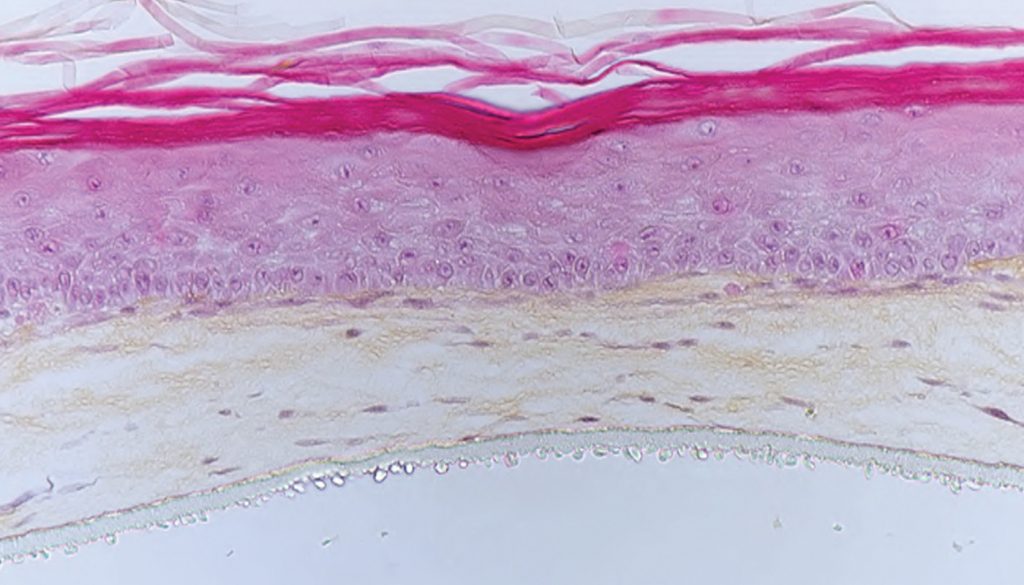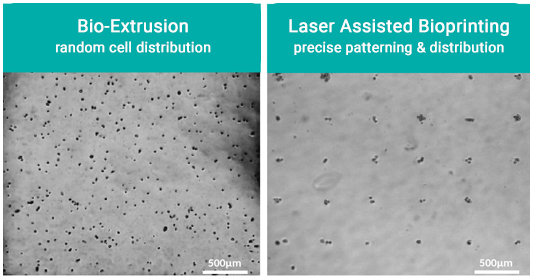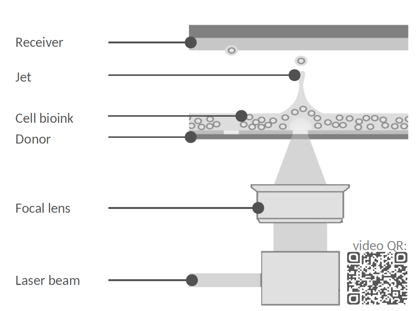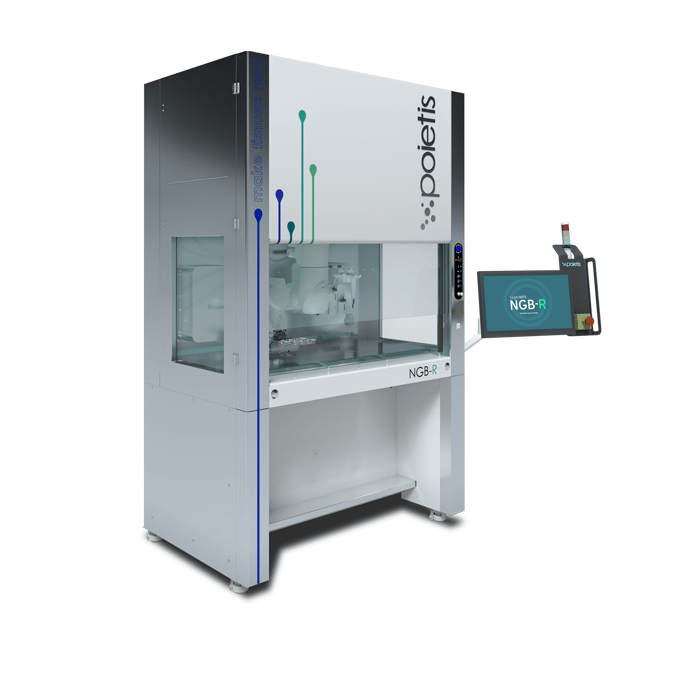Laser Assisted Bioprinting or LAB is a game-changing technology which is ideal for countless applications in regenerative medicine, tissue enginering and biology research. It offers a number of key advantages over other bioprinting techniques and is available on Poietis’ range of next generation bioprinting (NGB ) platforms suitable for research (NGB-R) and clinical (NGB-C) applications in conjunction with other complementary technologies such as bio-extrusion and micro-valve techniques providing high degrees of versatility. Combining these technologies has resulted in Poeitis’ multi-layer Poieskin, a human skin analogue.

Key Advantages
The main adavantages of LAB are:
- Significantly higher cell viability – > 95%
- Resolution – 10 µm
- Print Speed – 10,000 drops/sec
- Cell concentration – 100 million cells/mL

The Importance of Maximum Cell Viability
Laser-assisted bio-fabrication technology, a nozzle-free technique with no damage-causing forces occurring in the process. As a result, cell viability reaches >95% and printed tissues become truly functional.
This contrasts with other techniques that rely on extrusion-based technology with process-induced forces which induce cells damage and injury and cell viability as low as only 50%.
The Importance of Resolution, Accuracy and Print Speed
Single-cell resolution matters because it is the only way to guarantee the reproducibility and reliability of bioprinted tissues. Conventional bioprinting technologies cannot be used to reliably control the deposition of cells because they are deposited randomly. This means that the reproducibility and reliability of bioprinted tissues cannot be guaranteed. This would represent an unacceptable hurdle, not only for industrial production but also in terms of regulatory requirements for future clinical applications.

The NGB-R and NGB-C Bioprinters give tissue engineers and researchers superior resolution and precision. Boasting single-cell resolution capabilities and based on state-of-the-art robotics, automation, control and calibration technologies, Poietis technology reaches a peak in bioprinting precision.
In tissue biofabrication, the initial positioning of cells has a huge impact on the evolution of future tissues. While ordinary extrusion-based bioprinting techniques do not allow for precise positioning of printed cells within the hydrogel, NGB-R™ offers the unique possibility of accurately arranging cells exactly where and as desired. Poietis provides the solution with the first single-cell bioprinting platform that allows the design and manufacture of biological tissues by controlling both the resolution (the ability to print cell by cell) and the accuracy of printing (the ability to precisely position the cell in a 3D environment). In addition, the laser bioprinting speed is extremely fast: up to 10,000 droplets per second, allowing an entire patterned-layer of cells to be printed in just a few micro-seconds.
The Importance of Cell Concentration
Laser assisted bioprinting offers cell cocnentrations up to 10 million cells/mL which affords researcher greater flexibility depending on their specific requirements fro cell-cell interaction or integration of tissues grown in vivo.
Tissue Formation Modelling 4D – Where 3D becomes 4D
Poietis is developing a 4D bioprinting approach that consists of programming tissue self-organisation by designing tissue constituent organisations (cells and extracellular matrix) that evolve in a controlled way until specific biological functions emerge. Thus, by analysing tissue evolution during maturation, you can optimise the initial tissue architecture defined by CAD in order to improve the functionality of the printed tissues and guarantee that they are manufactured in the most reliable way.
How Laser Assisted Bioprinting Works
Laser-assisted bioprinting makes it possible to print cell by cell according to the following physical mechanism. The focusing of a laser pulse (in blue) on a cartridge (composed of an ink film spread on a glass plate) results in the formation of an ink jet towards a substrate on which cell microdroplets are collected. By controlling the physical conditions of the ejection (energy, viscosity…), the volume of the droplets is controlled precisely (~ picoliter).
The cell patterns are obtained by rapid scanning of the cartridge by the laser, which results in the formation of 10,000 droplets per second.

Applications of Laser Assisted Bioprinting
The human body contain about 200 different types of cells and about 20 different types of structures. Poeitis have successfully experimented with over 40 different cell types in their own labs or with academical and industrial partners.
Laser assisted bioprinting has potential applications in:
- Educational purposes – helping students to get familiar with bioprinting techniques and tissue CAD
- Biomaterials Bioengineering – developing and fine-tuning bioinks & bio-polymers for scaffold-making and biofabrication
- Tissue engineering – developing biological substitutes / tissue models for medical purpose (skin, liver, cartilage, pancreas, brain, hair follicles etc.)
- Oncology research – developing tumor / disease and organoids models for key cancer-research applications
- Cellular therapeutics – research on stem cell-based therapies and/ or tissue engineering for regenerative medecine applications
- Cosmetics & in vitro testing – test ingredients or firming actives, skin-care products and cosmetic efficacy evaluation
Laser assisted bioprinting has potential rto be used across a wide range of research areas.

Summary
The Poitis NGB-R platform is probably the most advanced and suitable system for translational research, covering areas such as cellular therapeutics, oncology research and tissue engineering.

